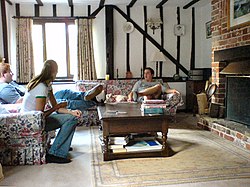Living room: Difference between revisions
No edit summary |
No edit summary |
||
| Line 1: | Line 1: | ||
{{unreferenced|date=September 2008}} |
{{unreferenced|date=September 2008}} |
||
[[Image:Sittingroom-edit1.jpg|thumb|right|250px|A [[Tudorbethan architecture|Tudorbethan]] sitting room in the UK.]] |
[[Image:Sittingroom-edit1.jpg|thumb|right|250px|A [[Tudorbethan architecture|Tudorbethan]] sitting room in the UK.]] |
||
| ⚫ | A '''living room''', also known as '''sitting room''', '''lounge room''' or '''lounge''' (in the United Kingdom and [[Australia]]), is a [[room (architecture)|room]] for entertaining guests, reading, watching [[television|TV]] or other activities. The word Lounge is from the Latin, it was brought over later on by the French. The term '''front room''' can also be used to describe a living room, because in many homes the living room is at the front of the house. |
||
A '''living room''', |
|||
| ⚫ | |||
In modern [[home]]s and [[apartment]]s, the living room has replaced the old-fashioned front [[parlor]].<ref name="isbn0-393-04861-6">{{cite book |author=Martin, Judith |title=Star-spangled manners: in which Miss Manners defends American etiquette (for a change) |publisher=W.W. Norton & Co |location=New York |year=2003 |pages=264 |isbn=0-393-04861-6 |oclc= |doi= |accessdate=}}</ref> In the 19th century, the front parlor was the room in the house used for formal social events, including where the recently deceased were laid out before their funeral. The term marks the twentieth-century effort of [[architect]]s and builders to strip the parlor of its burial and mourning associations. This room was relabeled with the more affirmative term "living room" in the 20th century. |
In modern [[home]]s and [[apartment]]s, the living room has replaced the old-fashioned front [[parlor]].<ref name="isbn0-393-04861-6">{{cite book |author=Martin, Judith |title=Star-spangled manners: in which Miss Manners defends American etiquette (for a change) |publisher=W.W. Norton & Co |location=New York |year=2003 |pages=264 |isbn=0-393-04861-6 |oclc= |doi= |accessdate=}}</ref> In the 19th century, the front parlor was the room in the house used for formal social events, including where the recently deceased were laid out before their funeral. The term marks the twentieth-century effort of [[architect]]s and builders to strip the parlor of its burial and mourning associations. This room was relabeled with the more affirmative term "living room" in the 20th century. |
||
Revision as of 18:50, 11 June 2009

A living room, also known as sitting room, lounge room or lounge (in the United Kingdom and Australia), is a room for entertaining guests, reading, watching TV or other activities. The word Lounge is from the Latin, it was brought over later on by the French. The term front room can also be used to describe a living room, because in many homes the living room is at the front of the house.
In modern homes and apartments, the living room has replaced the old-fashioned front parlor.[1] In the 19th century, the front parlor was the room in the house used for formal social events, including where the recently deceased were laid out before their funeral. The term marks the twentieth-century effort of architects and builders to strip the parlor of its burial and mourning associations. This room was relabeled with the more affirmative term "living room" in the 20th century.
A typical western living room will be furnished with a sofa, chairs, occasional tables, a television or stereo equipment, and bookshelves, as well as other pieces of furniture. Traditionally, a sitting room in the United Kingdom would have a fireplace. In Japan, people traditionally sat on tatami instead of chairs, but Western style decor is also common these days.
In the United States, sometimes the living room is reserved for more formal and quiet entertaining while a separate recreation room or family room is used for more casual activities and drinking. In recent years, the term "great room" has come to be used to denote the family room, especially if it is open to the kitchen, and may feature a vaulted ceiling.
References
- ^ Martin, Judith (2003). Star-spangled manners: in which Miss Manners defends American etiquette (for a change). New York: W.W. Norton & Co. p. 264. ISBN 0-393-04861-6.
